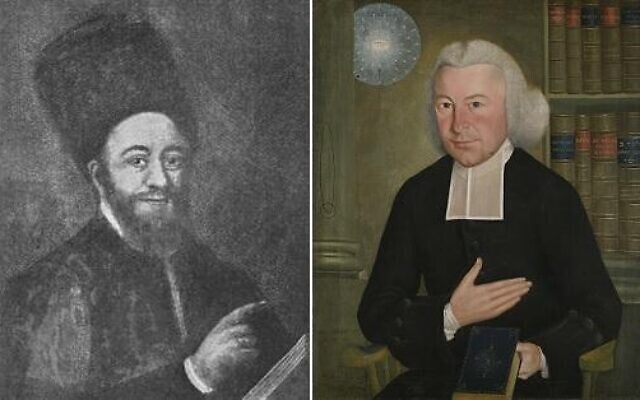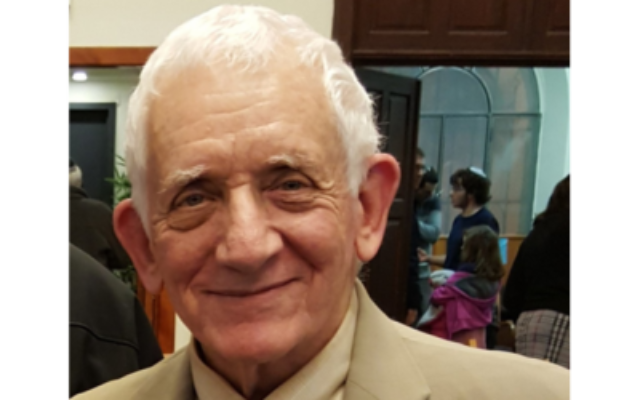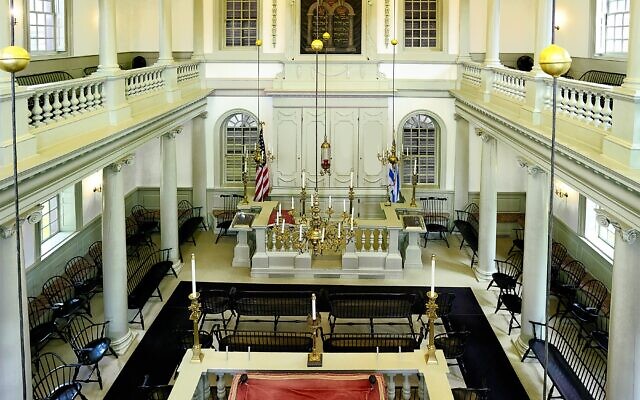Hebron Rabbi Spoke on Shavuot in 1773 Newport
The Israeli rabbi spoke on the holiday at the then decade old Touro Synagogue.
Rabbi David Geffen is a native Atlantan and Conservative rabbi who lives in Jerusalem.
Here is a piece I first wrote 40 years ago (unbelievable). The story once known, now forgotten.
The date was May 28, 1773, the first day of Shavuot 5533. The place: the Touro Synagogue in Newport, R.I. The rabbi who delivered the sermon was a visitor from Hebron, Palestine. The synagogue was filled for the holiday, not only with the members of Congregation Yeshuat Israel (initially called Nefutse Yisrael), but also the governor, a number of judges and the well-known minister Reverend Ezra Stiles.
He recorded in his diary that [Rabbi Haim Isaac] Carigal looked quite imposing. “He was dressed in his furr(sic) cap, scarlet robe, green silk damask vest, and a chintz undervest – girt with a sash or Turkish girdle, besides the alb (talit) with tzizith.”
Carigal’s sermon, timed by Stiles’ watch, was 47 minutes long, and it was given in Spanish, most probably Ladino with Hebrew interspersed. “His oratory, elocution and gestures were fine and oriental,” Stiles wrote. “It was very animated.” Such a sermon would normally have gone the way of many sermons – spoken never recorded. But the Jews of Newport were so fascinated by it they wanted to see it translated and printed in English. One member of the congregation, Abraham Lopez, prepared the translation and later in 1773 it was printed by the Newport Mercury and sold throughout the city, thus becoming the first sermon to be preached and published in the U.S.

Carigal was born in Hebron in 1729 and was ordained in 1749. In 1754, already a married man, he initiated his career as a “messenger of God” from the holy land. He began his first 11-year venture by traveling throughout the Middle East and the Caribbean islands. At each stop, he collected money for the schools of Hebron and for the city’s poor.
Arriving in Curacao in 1762, he was asked to remain and to serve as rabbi for the community. In that capacity, he instituted a program of religious education and even established a “talmudic academy.” Carigal also checked the imported kosher meat, invoiced as “smoke sassangers” and “peackle Jewish beeff” when it arrived from New York.
He arrived in the New England seaport of Newport just before Purim in 1773.
One of the first to hear of Carigal’s arrival was Rev. Stiles, a Christian Hebraist of note. As a student of the holy tongue, Stiles was always anxious to meet rabbinic visitors to the city and improve his knowledge of the Hebrew language. A few years later when Stiles became president of Yale College, he also taught Hebrew at the school.
He insisted that his students learn the Psalms in Hebrew. He reminded them “when you arrive in heaven, you will hear the Psalms in the original language. As your teacher, I would be most embarrassed if you could not understand what the angels were singing.”
When in March 1773, Stiles heard that “a Hebrew rabbi from the holy land” had arrived, the minister made sure to be in the synagogue for Purim services so he could meet the guest. In his definitive work on the Touro Synagogue, professor Melvin Urofsky quoted Stiles’ description of Carigal at the Purim service. “There I saw Rabbi Carigal I judge aet. about 45, lately from the city of Hebron, the Cave of Macpelah in the Holy Land. He was one of the two persons that stood by the Chasan(Chazan) at the Taubau or Reading Desk while the Book of Esther was read. He was dressed in a red garment with the usual Phylacteries and habiliments, the white silk Surplice; he wore a high brown furr Cap, had a long Beard.” Stiles noted in this fashion: “He has the appearance of an ingenious & sensible man.”
The rabbi struck his Christian observer as an “ingenious and sensible man, learned and truly modest far more so than I ever saw a Jew.” The two became fast friends and met on many occasions for a variety of discussions. The 19th century Christian historian Hannah Adams, in her book “The History of the Jews,” indicated that Stiles met with Carigal “for the purpose of acquiring pronunciation of Hebrew, of ascertaining the meaning of ambiguous in the original of the Old Testament, of conversing on past events relating to this extraordinary, as recorded in sacred history, and of tracing its future destiny by the light of prophecy.” Carigal was in Adam’s words, Stiles’ “Chocham Rabbi.”
For the holiday of Shavuot, it was decided by Aaron Lopez, leader of the town’s Jews, that Carigal should give the sermon. Christian notables, including the Gov. Joseph Wanton, judges [Peter] Oliver and [Robert] Auchmuty, and Stiles were invited so that they could see Newport Jewry putting its best foot forward.
Rabbi Carigal’s Shavuot sermon dealt with themes such as sin, study and the restoration of the holy land. Since it was Shavuot, the time of the giving of the Torah, there was a marked emphasis in the sermon on the need for study at home and in the synagogue. He strongly emphasized that the observance of the law was destined to restore the Jewish people to its homeland: “Let us have a firm belief in the innumerable prophecies that predict our restoration.” God would bring about the return, he stressed, when His people obeyed His moral law in their commercial dealings, in study and in loving their neighbors as themselves. Carigal concluded with the belief that in time, all the world will accept the ethical monotheism of Judaism and the “one voice:” In that day the Messiah might appear “daily, probably within the next forty years at least.”
According to Urofsky, “Carigal used no notes, but spoke extemporaneously. As he later told Stiles, he worked it out in his head and ‘sealed’ it there. At the urging of Stiles and others, Carigal wrote it out in Spanish and then it was translated into English.”
After five months in Newport, Carigal sailed to Surinam and then to the isle of Barbados, where he became the congregational rabbi in 1774. During the next three years, he corresponded with Stiles in Hebrew. One particular letter sent by Stiles in 1775 contained a moving description of the Battle of Bunker Hill, and concluded with the famous dictum, “The day is with the Lord.”
After settling into his post, Carigal felt that he was financially secure enough to bring his wife and children from Hebron to Barbados. Sadly, he had not seen them for over nine years. But before he could realize this goal, he contracted a disease and died in 1777. He was buried in the cemetery of Bridgetown, Barbados.
Stiles, who had become the president of Yale College, wrote Lopez of Newport in 1781 that “the affectionate respect I bear to the memory of Rabbi Carigal has made me wish that his picture might be deposited in the library of this college.” Lopez agreed.
 More than 250 years have passed, but Rabbi Carigal of Hebron’s impact on colonial America and on Jewish history remains. His sermon can be read, since it was reprinted in 1976 to mark the bicentennial of the United States of America. You can visit the Touro synagogue in Newport, preserved in a most pristine fashion. Carigal’s presence in Newport and his sermon provided an important spiritual link for this tiny American Jewish community. ì
More than 250 years have passed, but Rabbi Carigal of Hebron’s impact on colonial America and on Jewish history remains. His sermon can be read, since it was reprinted in 1976 to mark the bicentennial of the United States of America. You can visit the Touro synagogue in Newport, preserved in a most pristine fashion. Carigal’s presence in Newport and his sermon provided an important spiritual link for this tiny American Jewish community. ì
David Geffen is a former Atlantan and Conservative rabbi living in Jerusalem.




comments